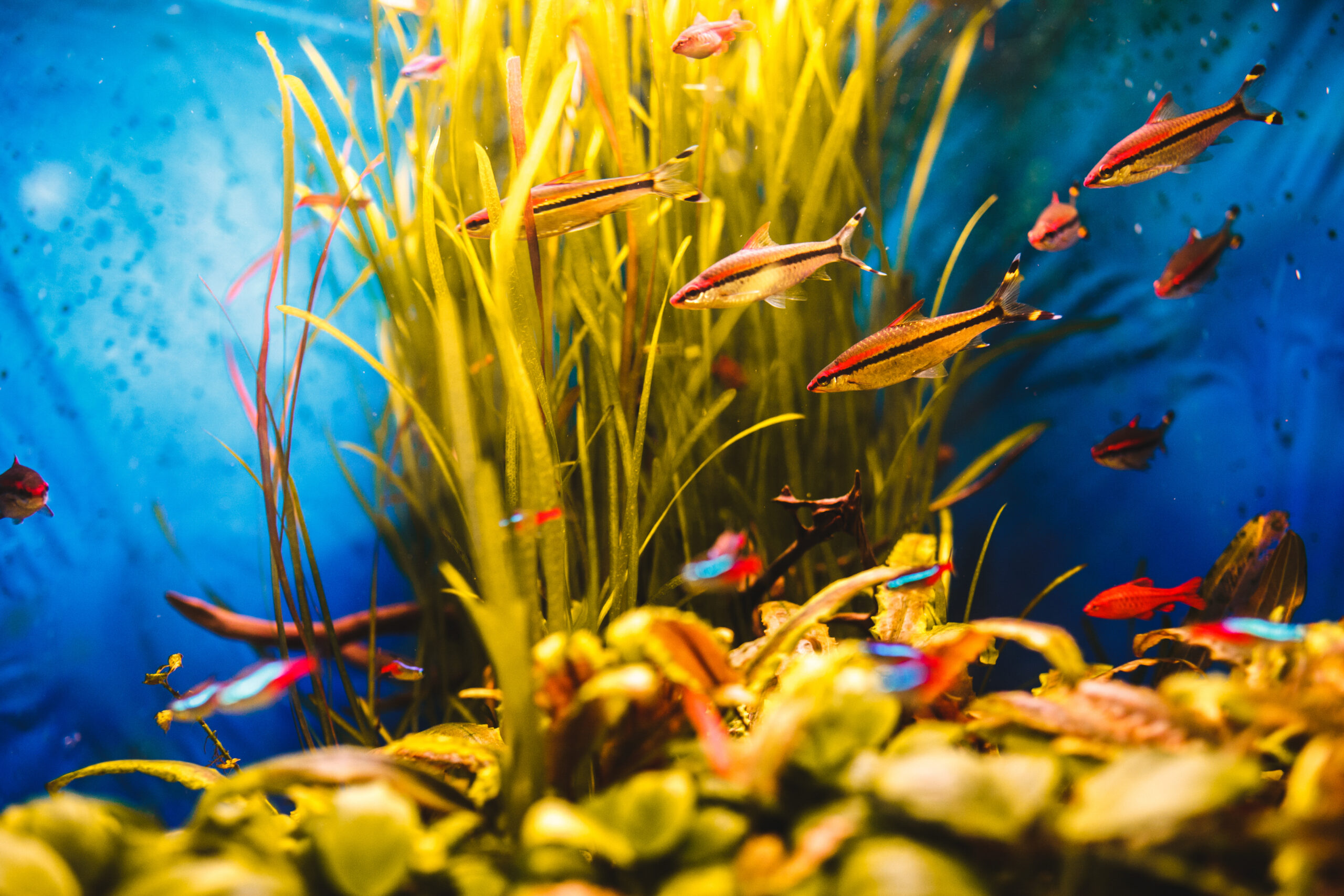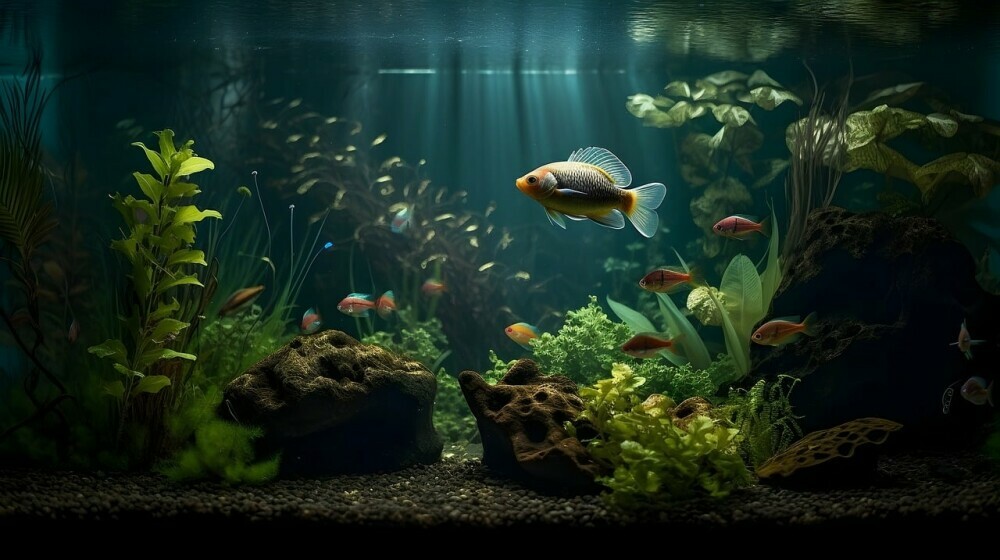How To Set Up A Freshwater Aquarium
So you’ve decided that you would like a low-maintenance pet of one or more fish. Although fish are relaxing and relatively low-maintenance, getting ready for your fish and setting up the tank will take some work to get started.
When setting up a freshwater aquarium, the first decision revolves around the size of the tank. This choice greatly depends on the species of fish you plan to keep, as well as how much room you have in your home. It’s vital to understand that different fish have different space requirements, and overcrowding can lead to stress, illness, and even fatalities.
Start by researching the adult size of the fish species you’re interested in. Tropical fish like neon tetras or guppies do well in smaller tanks, while larger species like angelfish or goldfish need more room. An aquarium that’s too small can restrict your fish’s growth and negatively impact their overall health. Additionally, more space provides a stable environment and makes maintaining water quality easier.
Here’s a simple guideline: a 10-gallon tank suits small fish like bettas or dwarf gouramis, while a 20-gallon or larger tank is better for medium-sized fish like platies or mollies. If you plan to keep larger species or a community of fish, a 30-gallon tank or more is ideal. Always err on the side of a larger tank if budget and space allow.  Choosing the right aquarium size brings several benefits. First, a well-sized tank reduces the risk of water quality fluctuations, which is crucial for your fish’s health. Second, it minimizes stress and promotes natural behavior, leading to more vibrant and active fish. And last, a spacious aquarium offers more room for decorations and plants, creating a visually appealing and stimulating environment for both you and your fish.
Choosing the right aquarium size brings several benefits. First, a well-sized tank reduces the risk of water quality fluctuations, which is crucial for your fish’s health. Second, it minimizes stress and promotes natural behavior, leading to more vibrant and active fish. And last, a spacious aquarium offers more room for decorations and plants, creating a visually appealing and stimulating environment for both you and your fish.
Setting Up and Maintaining Your Freshwater Aquarium
Setting up a freshwater aquarium starts with gathering the essential equipment. Filters are crucial in all size tanks as they help maintain water quality by removing debris, excess food, and harmful chemicals. Choose between hang-on-back, canister, or sponge filters based on your tank size and the type of fish you plan to keep. Heaters may be necessary to maintain a stable water temperature, especially if you’re housing tropical fish. Lighting not only enhances the appearance of your tank but also supports plant growth and fish health. As for the substrate, select gravel or sand depending on your aquarium’s plant and fish species.
Cycling your tank is an important step before introducing any fish. This process establishes beneficial bacteria that help break down waste products, creating a healthy environment. Start by adding a water conditioner to remove chlorine and chloramine from tap water. Test the water for ammonia, nitrites, and nitrates before adding any fish.
Monitoring water parameters ensures that your aquarium remains healthy. You can invest in a reliable test kit to regularly check key indicators like pH, ammonia, nitrite, and nitrate levels. Maintaining the appropriate pH level is crucial, as drastic changes can stress fish and harm plants. You can adjust these parameters as needed by partial water changes or using by commercial products.
If you don’t have the funds to invest in a reliable test kit when first starting out, most pet stores that sell fish will test your water for no charge. If your water’s out of balance, they can advise you on the best course of action to take to bring your water back to health. Bringing in a sample of your water before purchasing your first fish is always a good idea, even if you do your own testing.
Regular maintenance keeps your tank in top condition. Perform weekly water changes, replacing about 10-20% of the tank’s volume to remove waste and replenish minerals. Clean the substrate by using a gravel vacuum to remove uneaten food and debris. Replace or clean filters as needed.
If you have live plants, trim them occasionally and remove any dead or decaying leaves. This not only keeps your aquarium looking fresh, it supports healthy growth. If you want less maintenance, plastic plants can work just as well for foliage and additional cover for your fish. You can always have some of each to make your fish tank unique.
Feeding your fish properly ensures their health and longevity. Overfeeding is a common mistake that can lead to poor water quality and health issues. Feed your fish once or twice daily, offering only as much food as they can consume in a few minutes. Choose a balanced diet that suits your fish species, including high-quality flakes, pellets, and occasional treats like frozen or live food.
Common Problems in Freshwater Aquariums and Their Solutions
Freshwater aquariums can sometimes present challenges even with the best care. Recognizing the signs of trouble early helps you address issues before they become severe. Cloudy water, excessive algae growth, and odd fish behavior are all indicators that something isn’t quite right.
Cloudy water often results from a bacterial bloom, which can occur if your tank isn’t fully cycled or is overstocked. The fix involves testing water parameters and performing partial water changes. Reducing feeding and ensuring your filter is functioning properly can also help clear up the water.
Excessive algae growth is another common issue. This usually indicates too much light or an imbalance of nutrients in the water. Controlling the duration and intensity of your aquarium lighting can curb algae growth. Additionally, adding algae-eating fish or invertebrates like snails can help keep algae levels in check. Regularly removing algae manually and ensuring proper water circulation also makes a difference.
or invertebrates like snails can help keep algae levels in check. Regularly removing algae manually and ensuring proper water circulation also makes a difference.
Fish behavior can tell you a lot about their health. Lethargy, erratic swimming, or gasping at the surface often indicate poor water quality or disease. It’s essential to test your water immediately if you notice these behaviors. Consider isolating any sick fish in a quarantine tank to prevent the spread of disease. Make sure to research appropriate treatments based on the symptoms and diagnosis of the issue.
Perhaps one of the most dreaded problems is ick, or Ichthyophthirius multifiliis. Recognizable by small white spots on your fish, ick can spread rapidly and is highly contagious. The most effective treatment involves raising the tank temperature slightly to speed up the parasite’s life cycle, along with using a dedicated ick treatment available at pet stores. Removing carbon from your filter during treatment ensures the medication is effective. Quarantining affected fish is also recommended to prevent further spread.
Preventing common problems in your aquarium involves consistent care and observation. Regular water testing, proper feeding, and maintaining good filtration are your best defenses against potential issues. Staying informed and proactive can help you enjoy a thriving and beautiful freshwater aquarium.
Expert Tips for a Thriving Freshwater Aquarium
Creating a balanced and thriving freshwater aquarium environment requires some knowledge. Knowing how to avoid overcrowding is a must. Overcrowding can lead to stress, disease, and poor water quality. Ensure each fish has sufficient space by following a guideline of roughly one inch of fish per gallon of water, while considering each species’ specific needs.
Knowing how to select compatible fish species is important in preventing unnecessary conflicts of your fish. Research the temperament and habitat preferences of potential fish to create a peaceful community. Compatibility ensures your fish coexist harmoniously, reducing stress and promoting healthy behavior. If you’re unsure of what fish are compatible, your local pet store where you get your fish is a great place to start.
A stable aquatic environment is essential for fish to thrive. Consistency in water temperature, pH, and hardness supports healthy fish and plant life. Invest in quality equipment to maintain these parameters and regularly monitor them using test kits. Avoid sudden changes to the tank environment as they can shock your fish and lead to health issues.
Aquascaping involves designing the layout of plants, rocks, and other decorations in the tank. Not only does it enhance the tank’s appearance, but it also provides hiding spots and territories for fish, mimicking their natural habitat. Choose plants and decorations compatible with your fish species, and arrange them to create a visually appealing and functional layout.
involves designing the layout of plants, rocks, and other decorations in the tank. Not only does it enhance the tank’s appearance, but it also provides hiding spots and territories for fish, mimicking their natural habitat. Choose plants and decorations compatible with your fish species, and arrange them to create a visually appealing and functional layout.
Access to ongoing education and resources helps you stay ahead of potential problems and improve your aquarium care skills. Join online forums, subscribe to aquarium hobby magazines, and consider joining a local aquarium club. Networking with experienced hobbyists and professionals can provide valuable insights and support.
If any of this seems overwhelming, you can always start out with a bowl, some rock and a plant, and a couple of goldfish or a betta. The nice thing about having fish as a pet is that you can go as simple or fancy as you wish.
By implementing these tips you can create a thriving, harmonious freshwater aquarium. Proper planning, regular maintenance, and continuous learning are the keystones of success in this rewarding hobby.


Post Comment